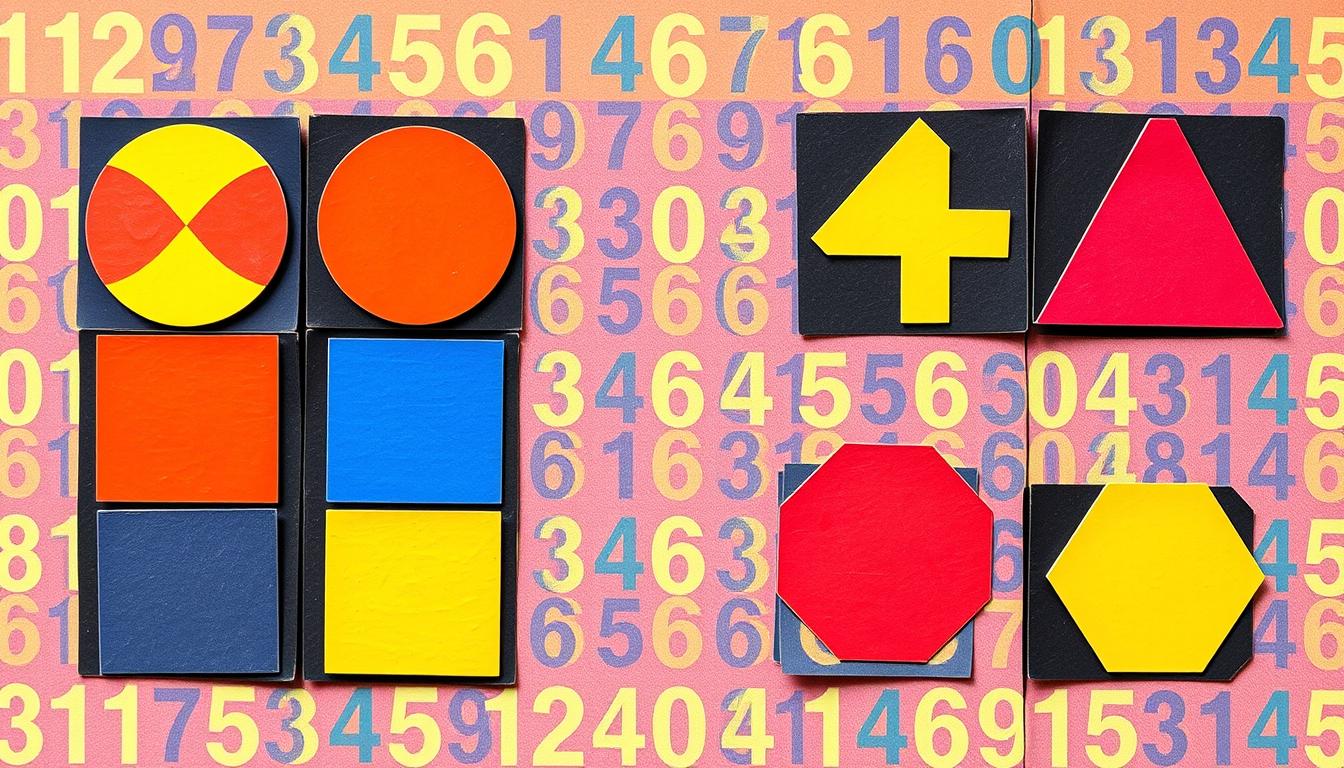Even Numbers and Odd Numbers: A Simple Math Guide
Table of Contents
Ever wondered about the difference between even and odd numbers? These basic math concepts are key to many operations. Yet, their details are often overlooked. In this guide, we’ll dive into what makes even and odd numbers unique, and how they’re used in everyday math.
We’ll start by learning what makes even numbers different from odd ones. Then, we’ll explore how division by 2 works, the special role of zero, and how these numbers look on a number line. We’ll also see how even and odd numbers behave in math, from simple addition to complex division.
Key Takeaways
- Even numbers are divisible by 2 with no remainder, while odd numbers leave a remainder of 1.
- The sum of two even numbers is always even, and the product of two even numbers is also even.
- Multiplying an even number by an odd number results in an even number.
- Even numbers have ending digits of 0, 2, 4, 6, or 8, while odd numbers end in 1, 3, 5, 7, or 9.
- Understanding the properties of even and odd numbers is essential for problem-solving in various mathematical disciplines.
Understanding Even Numbers and Odd Numbers
It’s key to know the difference between even and odd numbers in number theory and integer classification. These numbers have unique traits that matter a lot in divisibility and math.
Basic Definitions and Concepts
Even numbers can be divided by 2 without any leftovers. They usually end in 0, 2, 4, 6, or 8. Odd numbers, however, can’t be divided by 2 evenly. They end in 1, 3, 5, 7, or 9.
The Role of Division by 2
Division by 2 is very important in figuring out if a number is even or odd. Even numbers can be divided by 2 without any leftovers. Odd numbers, when divided by 2, always have a remainder of 1.
Zero’s Special Case
Zero is a special case. It’s considered an even number because it can be divided by 2 without any leftovers. This shows how unique even and odd numbers are in number theory.
“Understanding the fundamental differences between even and odd numbers is crucial in the realm of number theory and integer classification.”
Identifying Numbers Through Their Last Digit
Identifying even and odd numbers is easy when you look at the last digit. This method is simple and works for any number size. Just remember, numbers ending in 0, 2, 4, 6, or 8 are even. Numbers ending in 1, 3, 5, 7, or 9 are odd.
For example, 42 is even because it ends in 2. On the other hand, 79 is odd because it ends in 9. This digit recognition method is great for any whole number. It’s very useful for number recognition and ones place analysis.
| Even Numbers | Odd Numbers |
|---|---|
| 0, 2, 4, 6, 8 | 1, 3, 5, 7, 9 |
Learning this simple rule helps you quickly tell if a number is even or odd. This skill is very useful in math and solving problems.
“The ability to recognize even and odd numbers through their last digit is a fundamental skill in mathematics, enabling efficient problem-solving and number analysis.”
This easy technique is helpful for both small and big digit analysis tasks. It’s a good way to start understanding even and odd numbers.
Mathematical Properties of Even and Odd Numbers
It’s key to know the unique traits of even and odd numbers in math. These numbers follow certain rules and patterns. These are vital to grasp and use in many math situations.
Addition Properties
When you add two even numbers together, you get another even number. The same goes for adding two odd numbers. But, mixing an even and an odd number in addition gives you an odd number.
Multiplication Properties
Multiplying two even numbers always results in an even number. On the other hand, multiplying two odd numbers gives you an odd number. But, if you multiply an even number by an odd number, you get an even number.
Subtraction Properties
Subtracting two even numbers gives you an even number. Subtracting two odd numbers also results in an even number. But, subtracting an odd number from an even number gives you an odd number.
| Operation | Even Numbers | Odd Numbers |
|---|---|---|
| Addition | Even + Even = Even | Odd + Odd = Even |
| Multiplication | Even × Even = Even | Odd × Odd = Odd |
| Subtraction | Even – Even = Even | Odd – Odd = Even |
Understanding these basic rules of arithmetic operations, number properties, and modular arithmetic is essential. They help us apply math concepts in the right way.
Visual Representation on a Number Line
Seeing even and odd numbers on a number line makes them easier to understand. This visual tool helps students see the patterns and properties of these numbers.
Even numbers are spaced 2 units apart, starting from 0. This pattern shows even numbers every other spot. Odd numbers, on the other hand, are in between, alternating with even numbers.
Looking at the integer sequence on the number line, students can spot what makes even and odd numbers different. Even numbers can be divided by 2 without leftovers. Odd numbers can’t be divided evenly by 2.
This visual math helps students understand and see patterns. It makes connections and strengthens their knowledge of numbers. Using the number line helps build a strong foundation for math, especially for even and odd numbers.
General Forms and Patterns
In mathematics, knowing the general forms and patterns of even and odd numbers is key. These properties help us understand number sequences better. They also make it easier to work with them.
Even Number Patterns
Even numbers can be written as 2n, with n being an integer. This simple formula helps us spot and create even number sequences easily. For example, the sequence of even numbers is 2, 4, 6, 8, 10, and so on. Each number is 2 more than the last.
Odd Number Patterns
Odd numbers can be shown as 2n + 1 or 2n – 1, with n being an integer. This formula makes it easy to find and list odd number sequences. For instance, the sequence includes 1, 3, 5, 7, 9, and so on. Each number is 2 more than the one before it.
These patterns help us in number sequences and pattern recognition. They also give us a useful algebraic representation for more math explorations and uses.
| Characteristic | Even Numbers | Odd Numbers |
|---|---|---|
| Algebraic Representation | 2n, where n is an integer | 2n + 1 or 2n – 1, where n is an integer |
| Example Sequence | 2, 4, 6, 8, 10, … | 1, 3, 5, 7, 9, … |
| Ending Digits | 0, 2, 4, 6, 8 | 1, 3, 5, 7, 9 |
| Divisibility by 2 | Divisible by 2 | Not divisible by 2 |
Understanding these general forms and patterns of even and odd numbers is very useful. It’s not just for school; it’s also useful in many areas of math, like number theory, algebra, and solving problems.
Common Examples of Even and Odd Numbers
In our daily lives, we see even and odd numbers everywhere. They show up in addresses, phone numbers, and measurements. Knowing the difference between these numbers helps us see how math works in real life.
Even numbers, like 2, 4, 6, 8, and 10, can be divided by 2 without leftovers. They make up half of all numbers. Odd numbers, like 1, 3, 5, 7, and 9, can’t be divided by 2 and leave a remainder of 1. Odd numbers also make up half of all numbers.
The number 2 is special because it’s the only even prime number. Most prime numbers are odd. Composite numbers, which have more than two factors, can be both even and odd. They make up most of the natural numbers.
| Examples of Even Numbers | Examples of Odd Numbers |
|---|---|
| 2, 4, 6, 8, 10, 20, 46, 68, 100, 112, 446 | 1, 3, 5, 7, 9, 21, 49, 67, 89, 111, 555, 999 |
Seeing even and odd numbers in our daily lives helps us understand parity. It shows us how number theory applies in everyday math.
“Understanding the properties of even and odd numbers is crucial for developing strong number sense and problem-solving skills in practical applications.”
Applications in Real-World Mathematics
Knowing about even and odd numbers is key in many areas. They are vital in solving problems and in science. These numbers help in data analysis, computer coding, and finance.
Practical Uses
Even and odd numbers are used in many fields:
- In physics, they help describe waves like sound and light.
- Engineering uses them to study control systems and computer networks.
- In computer science, they help in creating data structures and algorithms.
- Finance uses them for currency exchange, interest, and investments.
Problem-Solving Strategies
Understanding even and odd numbers helps in solving problems. It’s especially useful in number theory and algebra. This mathematical reasoning is crucial for solving real-world problems and applied mathematics challenges.
- Even numbers’ symmetry makes calculations easier.
- Divisibility rules help in creating efficient algorithms.
- Even and odd properties solve algebraic equations.
- Parity helps analyze and classify numerical patterns.
Using even and odd numbers, professionals can solve problems better. They can tackle real-world problems more efficiently and accurately.
Understanding Number Sets and Integer Classification
Numbers are more than just even and odd. They belong to a larger group called number sets. Each set has its own special traits and uses in math. Let’s explore the world of number sets and integer types to understand numbers better.
The base is the natural numbers, which are all positive numbers from 1 to infinity. These numbers help us count and are used every day. Then, there are the integers, which include natural numbers, their opposites (negative numbers), and zero. The set of integers is shown as “Z” or “J” and includes numbers like -3, -2, -1, 0, 1, 2, 3, and so on.
We also have rational numbers, which are fractions or decimals that stop or repeat. On the other hand, irrational numbers are non-repeating, non-terminating decimals like π and √2.
The mix of rational and irrational numbers makes up the real numbers. This set includes all numbers on the number line. Beyond that, we find complex numbers, which are real numbers plus imaginary numbers in the form of a + bi.
| Number Set | Description | Examples |
|---|---|---|
| Natural Numbers | Positive integers from 1 to infinity, used for counting | 1, 2, 3, 4, 5, … |
| Integers | Positive, negative, and zero numbers | -3, -2, -1, 0, 1, 2, 3, … |
| Rational Numbers | Numbers that can be expressed as a ratio of integers | 1/2, 3/4, 5.25, 0.333… |
| Irrational Numbers | Numbers that cannot be expressed as a ratio of integers | π, √2, √5, e |
| Real Numbers | Union of rational and irrational numbers | All numbers on the number line |
| Complex Numbers | Consist of real numbers and imaginary numbers (a + bi) | 3 + 2i, -1 – 4i, 0 + 1i |
Understanding number sets and integer types is key in math. Knowing these categories and their properties helps solve math problems.
The study of number sets and integer types is rich and varied. Each type offers unique insights and uses. By learning these concepts, you’ll be ready to face many math challenges and improve your numerical skills.
The Connection Between Parity and Divisibility
In the world of number theory, parity and divisibility are closely tied. Parity, or whether a number is even or odd, is key to understanding divisibility. This section will dive into how these ideas connect, focusing on divisibility rules and remainders. These are crucial for mastering number theory and creating solid mathematical proofs.
Divisibility Rules
Even numbers can always be divided by 2, but odd numbers can’t. This rule applies to other divisibility tests too. For example, a number is divisible by 4 if its last two digits are also divisible by 4. Also, a number is divisible by 3 if the sum of its digits is a multiple of 3.
Remainder Concepts
Parity also affects remainders when dividing numbers. When dividing by 2, the remainder is 0 for even numbers and 1 for odd numbers. This pattern holds true for other divisors, giving clues about a number’s divisibility.
Understanding parity and divisibility helps us grasp number properties better. This knowledge is vital for number theory fans and has real-world uses in fields like computer science, cryptography, physics, and engineering.
| Divisibility Rule | Condition | Example |
|---|---|---|
| Divisibility by 2 | Last digit is even | 26 is divisible by 2, 7 is not |
| Divisibility by 3 | Sum of digits is divisible by 3 | 21 is divisible by 3, 15 is not |
| Divisibility by 4 | Last two digits are divisible by 4 | 1204 is divisible by 4, 1205 is not |
Exploring number theory, divisibility tests, and mathematical proofs deepens our understanding of numbers. This knowledge not only makes us appreciate math’s beauty but also sharpens our problem-solving skills. These skills are useful in many areas of study.
“The study of number theory is a never-ending journey of discovery, where even the simplest of patterns can lead to profound insights and groundbreaking mathematical advancements.”
Working with Large Numbers
Even and odd numbers aren’t just for small numbers. They apply to big integers too. To check if a large number is even or odd, just look at its last digit. This trick is super helpful in math and computer science, where we often work with big data and complex problems.
For example, take the number 56,789,012,345. To figure out if it’s even or odd, just check the last digit, which is 5. Since 5 is odd, the whole number 56,789,012,345 is odd too. This method works for any size number, making it a key tool in computer science and data work.
| Number | Last Digit | Parity |
|---|---|---|
| 14,789,123,456 | 6 | Even |
| 78,901,234,567 | 7 | Odd |
| 23,456,789,012 | 2 | Even |
By focusing on the last digit, we can quickly tell if a big number is even or odd. This is super useful in large integers, computational mathematics, and number manipulation. It makes complex math and data work easier and more accurate.
“The ability to quickly identify the parity of large numbers is a critical skill in the world of computational mathematics and data processing. By mastering this simple technique, we can unlock new levels of efficiency and accuracy in our work.”
Properties of Zero and Special Cases
Zero is a unique number in math. It’s not like positive or negative numbers. Zero doesn’t fit into the even or odd categories. This makes it special and important in advanced math.
Even though zero is divisible by 2, it’s not just like any other even number. It’s a special case. It’s the middle point between positive and negative numbers.
Zero’s properties are key to understanding special math cases. For example, “the sum of two odd numbers is always even” is true, except when one number is zero. Then, the sum is odd because zero doesn’t change the other number’s oddness.
- Zero is an even number, as it is divisible by 2 without a remainder.
- Zero is neither a positive nor a negative number; it is the dividing point between the two.
- The properties of zero can create exceptions to general rules about even and odd numbers, such as the sum of two odd numbers always being even.
Knowing about zero’s special status is vital in advanced math. It’s especially important in complex number systems, modular arithmetic, and abstract algebra. By understanding zero’s unique properties, we can handle math operations better and avoid common mistakes.
“Zero is a unique number that defies the typical classification of even and odd. Its special properties are crucial in understanding mathematical exceptions and advanced concepts.”
Common Misconceptions About Even and Odd Numbers
Learning about even and odd numbers is key for math students. But, many students face mathematical errors due to learning challenges. It’s vital to tackle these issues to grasp number theory well.
Some think all multiples of even numbers are even. But, odd multiples of even numbers are odd. For instance, 2, 4, and 6 are even, but their odd multiples are not always even. For example, 3 × 2 = 6 is even, but 7 × 2 = 14 is even, and 7 × 3 = 21 is odd.
Another mistake is thinking decimal numbers are even or odd like whole numbers. But, decimal numbers have their own rules and can’t be classified the same way.
- Students often struggle to recognize that even numbers are always divisible by 2, while odd numbers are not.
- Learners may also have difficulty understanding the patterns and properties of even and odd numbers, such as the fact that the sum of two even numbers is always even, and the sum of an even and an odd number is always odd.
- Misconceptions about the behavior of zero, which is considered an even number, can also lead to confusion among students.
By tackling these misconceptions and giving students hands-on experience with even and odd numbers, teachers can enhance their math skills. This helps students grasp number theory better.
“Understanding the fundamental concepts of even and odd numbers is crucial for students in mathematics.”
Conclusion
Understanding even and odd numbers is key for a strong math foundation. It boosts number literacy and problem-solving skills. These basics are the foundation for more complex math topics.
Knowing the patterns of even and odd numbers helps us solve many math problems. It makes us more confident and efficient, whether we’re dealing with big numbers or complex equations. A good grasp of this topic is very useful.
In Nigeria, learning about even and odd numbers is very important. It helps students do well in math and other subjects. By focusing on this topic, we can raise a generation of skilled problem-solvers and thinkers.
FAQ
What are even numbers and odd numbers?
Even numbers are whole numbers that can be divided by 2 without any leftovers. They end in 0, 2, 4, 6, or 8. Odd numbers can’t be divided by 2 evenly. They end in 1, 3, 5, 7, or 9.
How can I identify even and odd numbers?
To tell if a number is even or odd, look at its last digit. Numbers ending in 0, 2, 4, 6, or 8 are even. Numbers ending in 1, 3, 5, 7, or 9 are odd.
What are the properties of even and odd numbers in arithmetic operations?
When you add two even numbers together, you get an even number. Adding two odd numbers also gives you an even number. But, adding an even and an odd number gives you an odd number.
When you multiply two even numbers or an even and an odd number, you get an even number. But, multiplying two odd numbers gives you an odd number. Subtraction works the same way.
How are even and odd numbers represented on a number line?
On a number line, even numbers are spaced 2 units apart, starting from 0. Odd numbers are in between the even numbers, making a pattern.
What are the general forms for even and odd numbers?
Even numbers can be written as 2n, where n is any whole number. Odd numbers can be written as 2n + 1 or 2n – 1.
What are some common examples of even and odd numbers?
Examples of even numbers are 2, 4, 6, 8, 10, and so on. Odd numbers are 1, 3, 5, 7, 9, and so forth.
What are the practical applications of understanding even and odd numbers?
Knowing even and odd numbers is key in many areas. It’s used in data analysis, computer programming, and finance. It also helps in solving math problems, especially in number theory and algebra.
How is the concept of parity related to divisibility?
Even numbers can be divided by 2 without any leftovers. Odd numbers can’t. This rule helps us understand other divisibility rules and remainders in division.
How do the properties of zero impact the classification of even and odd numbers?
Zero is an even number because it can be divided by 2 without any leftovers. Knowing this is important in advanced math and helps clear up common mistakes about even and odd numbers.
What are some common misconceptions about even and odd numbers?
Some people think all multiples of even numbers are even (which isn’t true for odd multiples). Others think decimal numbers can be even or odd, but that’s not right.





